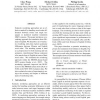73 search results - page 2 / 15 » A Discriminative Syntactic Word Order Model for Machine Tran... |
ACL
2009
13 years 2 months ago
2009
Often, Statistical Machine Translation (SMT) between English and Korean suffers from null alignment. Previous studies have attempted to resolve this problem by removing unnecessar...
EMNLP
2009
13 years 2 months ago
2009
In this work, we propose two extensions of standard word lexicons in statistical machine translation: A discriminative word lexicon that uses sentence-level source information to ...
MT
2010
13 years 3 months ago
2010
This paper introduces deep syntactic structures to syntax-based Statistical Machine Translation (SMT). We use a Head-driven Phrase Structure Grammar (HPSG) parser to obtain the de...
IJCNLP
2005
Springer
13 years 10 months ago
2005
Springer
In this paper, we present an empirical study that utilizes morph-syntactical information to improve translation quality. With three kinds of language pairs matched according to mor...
EMNLP
2007
13 years 6 months ago
2007
Syntactic reordering approaches are an effective method for handling word-order differences between source and target languages in statistical machine translation (SMT) systems. T...

